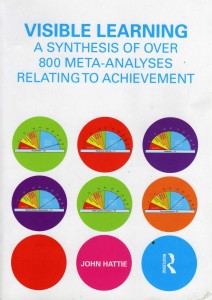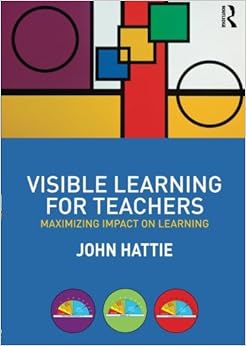 Within Ingham County, John Hattie's work is a frequent topic of conversation. In fact, the Leadership PLC has spent the last two years unpacking two of his books and will be spending this year unpacking the third! (see pictures below). As I have read parts of these books and watched his video lecture, I can't help but think about the flipped classroom and how it relates to his research.
Within Ingham County, John Hattie's work is a frequent topic of conversation. In fact, the Leadership PLC has spent the last two years unpacking two of his books and will be spending this year unpacking the third! (see pictures below). As I have read parts of these books and watched his video lecture, I can't help but think about the flipped classroom and how it relates to his research. For those of you who are unfamiliar, Hattie synthesizes over 800
For those of you who are unfamiliar, Hattie synthesizes over 800meta-analyses relating to student achievement in his Visible Learning book. He developed an effect size for each influence on student achievement and ranks them in Appendix B. He discusses the fact that simply by living, students show an achievement effect size of .15, so we must look at least above that threshold. He sets the bar at .40 as the average effect size. He discusses his "winners" as those above .50 effect size or so.
As I looked through the list and heard him talking about the list, I was truly amazed at how well these influences are linked to the flipped classroom.
Here's a few that are particularly impressive and are directly tied to the flipped classroom and flipped learning (Hattie, 2009)
- Providing formative evaluation (.90)
- Acceleration (.88)
- Feedback (.73)
- Formative evaluation of programs (.90):
- Reciprocal Teaching (.74)
- Direct Instruction (.59)
- Teacher-Student Relationship (.72)
- Teaching learning strategies (.62)
- Classroom discussion (.82)
- Spaced versus mass practice (.71)
- Classroom behavior (.68)
- Self verbalization/self questioning (.64)
- Surface level homework (less than 1 hour for secondary has largest effect size).

In the Visible Learning for Teachers book, Hattie lays out a "Checklist for 'visible learning inside.'" I thought about my own flipped classrooms as well as those that my colleagues within the #flipclass community describe in their blogs and conference presentations and highlighted the items on the list that are present in a well-done flipped classroom (Hattie, 2012)
Planning
- invoke appropriate challenges that engage the students' commitment to invest in learning.
- capitalize on and build students' confidence to attain the learning intentions.
- lead to students having goals to master and wishing to reinvest in their learning.
- have learning intentions and success criteria that are explicitly known by the student.
Starting the Lesson
- The climate of the class, evaluated from the student's perspective is seen as fair: students feel that it is okay to say 'I don't know' or 'I need help'; there is a high level of trust and students believe that they are listened to; and students know that the purpose of the class is to learn and make progress.
- The classrooms are dominated more by dialogue than by monologue about learning.
- The classrooms are dominated more by student learning than teacher question.
- There is a balance between teachers talking, listening, and doing; there is a similar balance between students talking, listening, and doing.
- Teachers and students use the power of peers positively to progress learning.
- Teachers choose the teaching methods as a final step in the lesson planning process and evaluate this choice in terms of their impact on students.

During the lesson: learning
- Teachers provide differentiation to ensure that learning is meaningful and efficiently directed to all students gaining the intentions of the lesson.
- Teachers are adaptive learning experts who know where students are on the continuum from novice to capable to proficient, when students are and are not learning, and where to go next, and who can create a classroom climate to attain these learning goals.
- Teachers are able to teach multiple ways of knowing and multiple ways of interacting, and provide multiple opportunities for practice.
- All students are taught how to practice deliberately and how to concentrate
During the lesson: feedback
- Teachers are aware of, and aim to provide feedback relative to, the three important levels of feedback: task; process; and self-regulation.
- Teachers provide feedback appropriate to the point at which students are in their learning, and seek evidence that this feedback is appropriately received.
- Teachers use multiple assessment methods to provide rapid formative interpretations to students and to make adjustments to their teaching to maximize learning.
The end of the lesson.
- Teachers provide evidence that all students feel as though they have been invited into their class to learn effectively. This invitation involves feelings of respect, trust, optimism, and intention to learn.
- Teachers create opportunities for both formative and summative interpretations of student learning and use these interpretations to inform future decision making about their teaching.
Mind Frames
- Teachers want to talk more about the learning than the teaching.
- Teachers see assessment as feedback about their impact
- Teachers believe that it is their role to develop positive relationships in classrooms.
Works
Cited
Dunn, Jeff. Flipped-Classroom1. Digital image. Edudemic. Edudemic, 5 Dec. 2011. Web. 19 Sept. 2014.
<http://edudemic.com/wp-content/uploads/2011/12/flipped-classroom1.jpg>.
Hattie, John. Visible
learning: a synthesis of over 800 meta-analyses relating to achievement.
London: Routledge, 2009. Print.
Hattie, John. Visible
learning for teachers: maximizing impact on learning. London: Routledge,
2012. Print.
Hattie, John .
"Influences on Achievement." Open Universiteit Nederland. Open
Universiteit. Open Universiteit, AT Heerlen. 1 May 2011. Lecture.